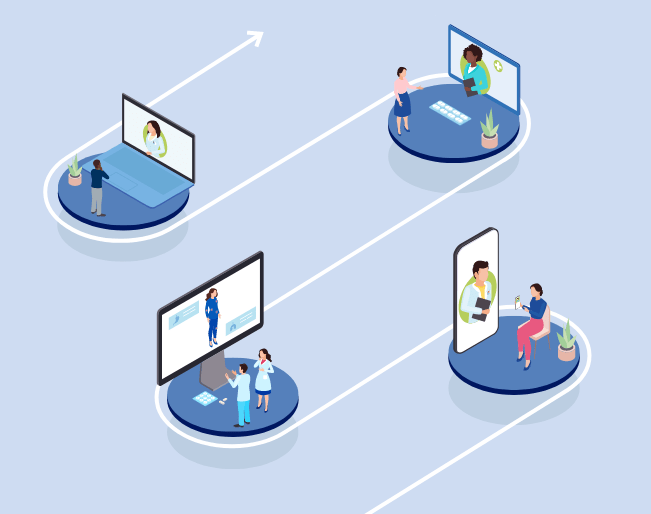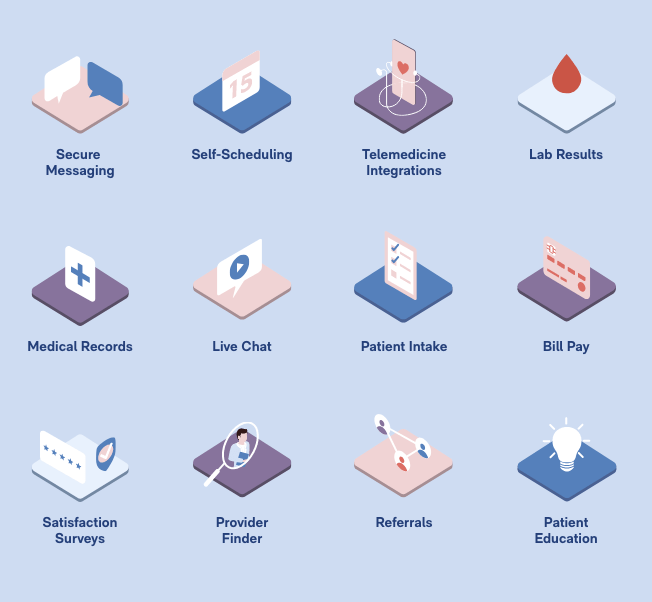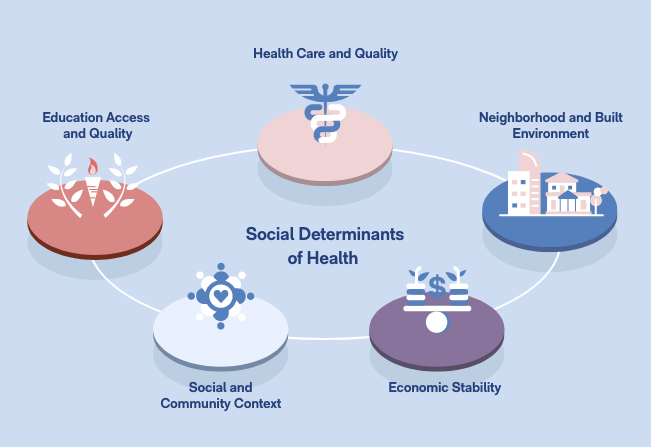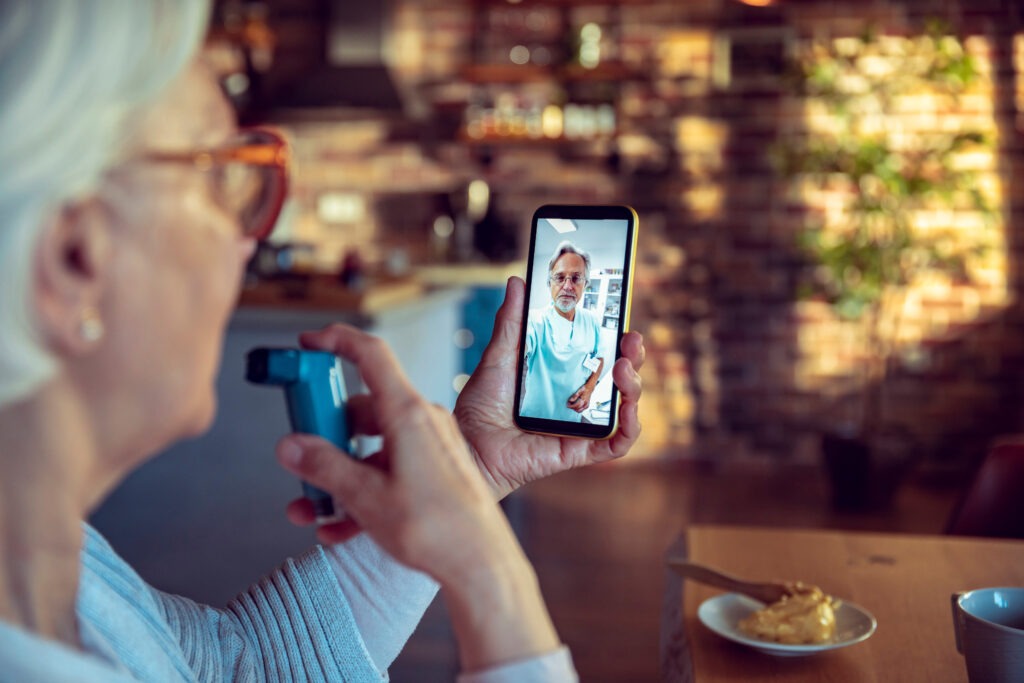The consumerization of healthcare
As consumers feel the impact of rising out-of-pocket healthcare costs, they are looking for greater value for their money and the kind of customer experience that mirrors that of other service sectors. These shifting expectations have reversed the dynamic between patients and healthcare providers. Consumers are now in the driver’s seat, wanting more control over their healthcare and seeking convenience, seamless communication, and instant access to their personal health information.
To bridge the gap between rising patient expectations and healthcare operations, leading healthcare providers are implementing a digital front door strategy that focuses on providing patients with the kind of access, flexibility, and self-service convenience that they’ve come to expect in a digital world.
What is a digital front door strategy?
A digital front door is a consumer-centric approach that uses technology to connect patients and providers at every touchpoint along the patient care journey. By leveraging devices that consumers have already adopted for personal use, a digital front door delivers an integrated, seamless healthcare experience that deepens patient engagement and gives consumers more visibility into their own health management.

Why is a digital front door important today?
According to a McKinsey report, telemedicine has sustained an astonishing 3,800% increase over its pre-COVID baseline, dramatically eliminating the need for many in-person patient visits. During the initial stages of the pandemic, telemedicine offered a critical and convenient bridge to care. Now that patients can resume in-person visits, both consumers and providers alike see the many benefits of a long-term virtual care strategy.
Upside of virtual care
The positive impact of virtual care extends to both consumers and providers. From a patient perspective, 76% of surveyed consumers expressed an interest in telehealth. On the provider side, 58% of clinicians view telehealth more favorably now than they did before the start of the pandemic. Virtual care is here to stay, and health systems must increasingly look for new ways to deliver patient-driven care. A digital front door strategy can connect patients to the care they need, when and where they need it – delivering value-based care beyond physical walls.
Virtual care opens endless possibilities that can improve access to care while also containing costs. From triaging patients remotely to managing chronic illness at home, here are just a few patient and provider advantages:
Patient benefits
- Enables consumers to easily access care when they need it, through channels that are most convenient for them
- Improves patient experience
- Reduces infection rates
- Improves assessment
- Strengthens family support
- Improves chronic condition management
- Aids patients with limited mobility
- Expedites timely care
Provider advantages
- Drives efficiency in processes such as appointment self-scheduling and care- coordination
- Reduces emergency department visits
- Enhances clinician satisfaction, reduces burnout
- Decreases patient transfers
- Reaches a larger patient population
- Improves access to care in rural communities
- Reduces repetitive tasks, freeing up staff for more value-added tasks
- Helps to attract new patients and retain them
- Reduces readmissions
How does a digital front door work?
A digital front door strategy improves patient access to care by using a wide range of digital services and features. From scheduling their own appointments to managing chronic care at home, patients can tap into a broad range of services through a single access point. All a patient needs is a mobile device or access to the internet.

A digital front door provides patients with a single access point for all their virtual interactions. It serves an entry point into a host of provider services, accessible – whenever and wherever.
How a digital front door improves patient outcomes
With rising expectations for on-demand health services, it’s not surprising that a growing number of consumers are choosing health care providers based primarily on their digital offerings. According to a study by NRC Health, 77% of patients begin their healthcare search online, which makes it critically important for hospitals and health systems to implement a digital front door strategy that can effectively engage consumers by providing online access to:
- Location data and hours of operation
- Self-scheduling
- Virtual interactions and appointments
- Estimated wait times for emergency and urgent care
Further, an effective digital front door approach uses a broad range of digital devices and features to create an integrated, frictionless healthcare experience at every touchpoint in the patient’s journey. From appointment scheduling to follow-up care, a digital front door can help empower consumers to take a proactive role in their health, using their own devices to access health services and information when it’s most convenient for them. This anytime-anywhere access can remove barriers to care and promote proactive care management.
A digital front door can address social determinants of health
Removing barriers to care is particularly significant for populations with limited access to healthcare. A key determinant of health is access to affordable and decent healthcare services. A virtual care model can help improve access to care in rural and urban areas where, according to the NIH, barriers to healthcare include:
- Patient complexity
- Resource limitations
- Service access
- Training constraints
- Patient avoidance of care

In the global effort to achieve health equity, a digital front door approach can help move us one step closer. Through a single point of access to clinical assessment, virtual visits, health education, and personal health records, it’s now possible to provide access to those at greatest risk of poor health due to social conditions.
How to implement a digital front door strategy
With the growing ability to expand healthcare access to a broader population, a digital care strategy is now more important – and attainable – than ever.
Before the pandemic, there were several roadblocks to implementing a digital front door strategy. Among the challenges were technical capabilities, stakeholder buy-in, user adoption, and concerns about privacy and regulatory compliance. But as the pandemic abruptly forced consumers into remote care models, the shift sparked explosive growth in virtual health services, the majority of which are now here to stay. This broad acceptance of virtual care services among both patients and providers has now opened the digital door to a host of opportunities that can help connect, engage, and monitor patients outside the physical walls of a building. As organizations see the upside and growing necessity of providing a full suite of digital care services, the next step is knowing where to begin. Here’s 10-step plan that can get you started.
Digital front door implementation: 10 tips
1. Plan to increase your investment in digital care
According to a HIMSS report, 80% of health systems plan to increase their investment levels in technology and digital healthcare over the next five years. As patients increasingly demand digital convenience, many organizations recognize the importance of integrating digital solutions into their existing infrastructure to help them attract new patients and retain them.
2. Get everyone aboard and aligned
Prior to the pandemic, getting everyone on board with a digital care model took Herculean efforts. Concerns ranged from technophobia to security risks. In healthcare today, there is no room for laggards. Find your digital champions and elevate them to leadership roles.
3. Map an outline, identify gaps, and prioritize digital touch points across your service ecosystem
As you begin analysis for your digital front door strategy, map an outline of existing digital touch points across your service continuum. Identify gaps and then prioritize technologies that you’ll need to fill these gaps. Currently, there is no standalone solution that can serve as an all-in-one plug and play. You’ll need a team that can help you identify vendors and evaluate solutions that can be integrated into your existing infrastructure.
4. Achieve interoperability throughout your digital ecosystem
Seamless data sharing between systems is critical to protecting privacy and meeting regulatory requirements. To achieve true interoperability and ensure the secure exchange of information throughout your ecosystem, it’s imperative to select providers with interoperability specialization in healthcare.
5. Focus your efforts on user design and the digital experience
Many younger consumers are choosing health care providers based primarily on their digital offerings, according to a recent NRC Health study. An integrated and seamless customer experience is critical to attracting patients and retaining them. Where patient expectations previously focused on the technical quality of medical care, now the emphasis is shifting to convenience, cost, and personalized service.
6. Clearly represent your offerings
Today’s consumers expect instant access to information. Be sure to present your services and offerings clearly and through an interactive design that will engage visitors. This initial touchpoint is the digital front door through which all interactions can occur.
7. Develop a digital triage tool
Consumers typically search the web when they develop symptoms. This serves as one of the best opportunities to engage and acquire new patients. Symptom triage tools, like AI chatbots, can be used effectively to qualify patient needs and direct them to the right offerings.
8. Offer online self-scheduling and digital check-in
Patient self-scheduling is one of the easiest ways to increase patient engagement and minimize cancellations and no-shows. Scheduling an appointment is generally a patient’s first interaction with a healthcare provider. First impressions are critical, so it’s important to create a seamless process for online appointments and check-ins.
9. Incorporate online payment tools
Improve claims management and reduce long reimbursement timelines. By incorporating online payment tools, you can reduce payment collection timelines, non-payment rates, and eliminate costs and time associated with manual payments.
10. Partner with internal IT on security and integrations
No one knows your security risks better than your IT department. Leverage your team’s knowledge and experience by fully engaging IT in your digital front-door implementation. An integrated security system is central to information flow and can increase response times across all systems.
What’s the ROI on digital front door implementation?
To demonstrate value, a digital front door transformation must use hard ROI – figures that can be quantified. Given the complexity of hospitals and health systems, collaboration with a trusted partner will be essential in developing an ROI model for your stakeholders. As you set out to examine your level of investment in digital offerings, or future software development consider these figures.
Digital front door: Figures and facts
40-60%
of consumers express interest in a set of broader virtual health solutions, such as a “digital front door” or lower-cost virtual-first health plan
Savings and benefits to providers
30%
Virtual care has helped providers cut hospital ED costs by more than 30%
60%
of surveyed physicians feel virtual care allows them to provide more comprehensive quality care
40%
More than 80% of surveyed physicians agree that patients have better access to care since they began providing it virtually
50%
More than 50% of physicians indicate virtual care has increased their professional satisfaction, reducing clinician burnout
24%
of healthcare office visits and outpatient volume could be delivered virtually
35%
of regular home health attendant services could be virtualized, providing a patient comfort and convenience
Savings and benefits to consumers
$100
Virtual care reduces patient healthcare costs by about $100 per visit
$19 and $121
Patients saved on average between $19 and $121 using telehealth, primarily by avoiding trips to the ED
$120
Seeing a specialist averages $120 less for a virtual visit than an in-person visit
$141
A virtual urgent-care visit averages $141 less than being seen in an urgent care clinic.
$93
A virtual care visit for a non-urgent health concern was $93 less than the average cost of an in-person visit



